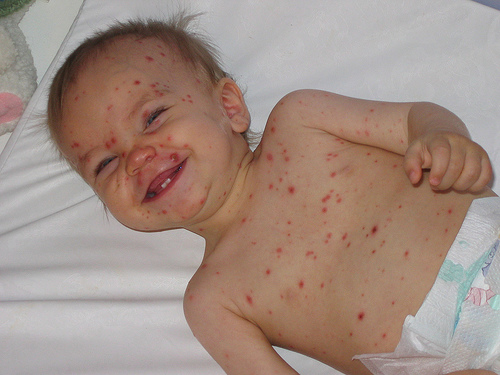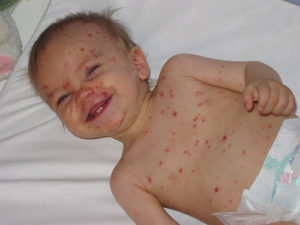Chickenpox is a common contagious childhood disease. The disease occurs mainly in children, because most adults have become immune to. The severity of chickenpox is small unless newborns, pregnant women and adults are infected with it. They experience the illness as violent and have a greater chance of complications. What is chickenpox? How do you get it? How do you deal with? And when should you go to the doctor?
Chickenpox is characterized by spots, blisters and scabs on the skin. It is a very common childhood disease. 75% of the people get chickenpox between the 1st to 6th years of life. When the disease among members has had one here is generally immune. If the disease is a mild disease course had then the chance that a child again in a load can get chickenpox. A mild course of disease is most common in babies until their first birthday, as they have antibodies to that time with them that they have inherited from their mother.
The probability that an adult gets sick of chicken pox is very small, even if they never become infected with the virus. Over the years, builds a person had sufficient antibodies to counter the disease at bay. Touch your old age will become infected the disease process and potential complications are more severe than in children. Even newborn babies and pregnant women will experience severe disease.
In general, chicken pox is not harmful to unborn. A woman becomes infected when less than 16 weeks pregnant then there are however likely to abnormalities in the baby. Even if a woman is pregnant and get chickenpox are the dangers to the baby grows. They will do well to treatment as soon as the doctor visit.
Pathogen
Chickenpox is caused by a virus, varicella zoster virus.
Way of infecting
The varicella zoster virus is located in the throat and nose of an infected child. The virus is spread among others by coughing, sneezing and talking. The moisture that comes from the vesicles is very contagious. The blisters once dried up than the risk of infection is gone. The contagiousness of the disease starts 1 day prior to the onset of the spots.
Incubation period
Incubation period is the time between infection and the outbreak of the disease. The incubation period for chickenpox is 2 to 3 weeks.
Disease Symptoms
- Mild fever
- Listlessness
- Headache
- Pink spots on the head, torso, neck and mouth
- Sores on the head, torso, neck and mouth
- Scabs on the head, torso and neck
- Spots, blisters and scabs can simultaneously present on the skin
- Itch.
Course of the disease
A child who received the varicella zoster virus has accumulated will first experience a slight fever. The temperature rises to about 39 degrees. The child may suffer from listlessness. After 1 to 2 days creates pink patches on the forehead and behind the ears. These spots expand into the trunk. They are slightly above the skin. The spots turn into blisters. These blisters can be very itchy. By the itch scratches a child they usually open, but they can also jump naturally open. When the blisters are concerned they will undoubtedly open for subsequent scars. Besides are the wounds sensitive for infections.
Dry the blisters in within a few days. There are scabs on the skin. When the scabs fall off the disease is gone. This is about 9 to 13 days after the outbreak of the disease. The overall disease process usually takes about 2 to 3 weeks.
Complications
- Infection of open sores
- Scarring (due to open sores)
- Pneumonia
- Lung Infection
- Brain inflammation (encephalitis)
- In later life: Shingles (varicella zoster virus after infection remains latent in the body. Later in life the virus can become active and cause shingles. Shingles can place then give chickenpox susceptible children.)
Treatment / care
There is no specific curative treatment for chickenpox. A child should be out sick. However, measures can be taken to the child as comfortable as possible. Use menthol powder on the skin to relieve itching. It may be that the child has sores in the mouth. This hurt instead of that they itch. Give the child soft foods and popsicles to this pain. It is wise to the child’s nails short to cut. He may be less than scratching the blisters.

